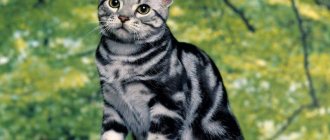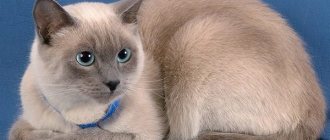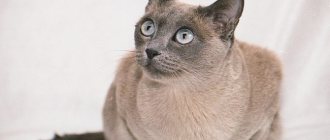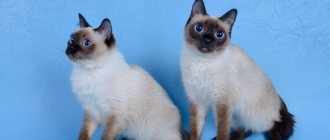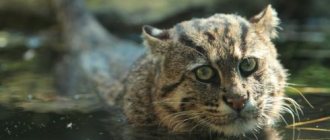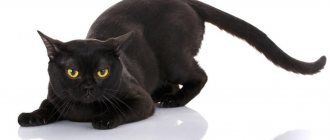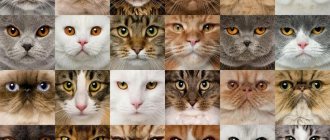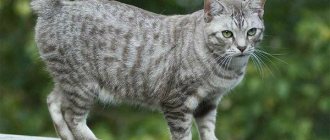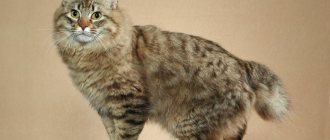Siamese have beauty, grace and blue eyes. There are cats similar to Siamese. They are similar in color, but also differ slightly in appearance, coat length and habits. Some pets have a calm disposition, while others, on the contrary, are active and playful. The breeds most similar to Siamese are Seychelles, Balinese, Thai and Himalayan cats, Mekong Bobtail, Javanese, and Peterbald.
Balinese
This cat breed got its name thanks to the plasticity and grace that cats have, named after the Balinese temple dancers.
This is a miniature, slender cat with unique grace. She is fluffier than the Siamese, she has an elongated body and long legs. The average cat weighs up to 4 kilograms.
Representatives of this breed are less aggressive than Siamese, friendly, sociable and very attached to their owner.
Cats similar to Siamese in color
There are more than forty varieties of this breed. It is not surprising that people often cannot identify true Siamese and their own kind. Some of them have a very similar color, and some are slightly different.
Thai cat
Thai cat
Thai cats are similar to Siamese, and more so than anyone else. Quadrupeds are larger and fluffed, although if a person is not well versed in breeds, he can easily confuse two different representatives. Those Thai cats that exist today are similar to those Siamese that lived several centuries ago.
Today, representatives of the breed have the following features:
- Weight – on average from 3.5 to 7 kg.
- The coat has no undercoat and is absolutely smooth.
- Personality – sociable, love to be around people.
It’s difficult to say anything about the color, because the color of the fur coat is almost the same as that of the Siamese. As for the eyes, their color is sky blue, and their shape resembles almonds. If you already have animals in the house and really want to get yourself a Thai, this won’t be a problem. Representatives of this breed get along well with cats, dogs, and other animals. Thais are often called “talkers” because they love to “communicate” through meowing. In this, by the way, they are similar to their feline ancestors, the Siamese. The Thai cat is rarely seen today, although many people like this particular breed because it has a number of its own characteristics and distinctive characteristics.
Burmese cat
Burmese cat
Sacred Burma is the name given to Burmese cats. Representatives of the breed are similar to Siamese, but only very fluffy. This is the nuance that distinguishes four-legged animals from their own kind. At the same time, if furry animals do not have white “socks” on their paws, then they can no longer be classified as purebred representatives of the breed.
Distinctive features of Burma:
- Weight – about 6 kg.
- The coat is medium length and soft.
- Personality – active, but calm and soft.
Many people pay attention to this breed because it has a non-conflict nature. The animal doesn’t care who lives next to it, no jealousy will arise anyway. Kittens in most cases are born snow-white, and only by six months the fur acquires the tone that will remain with the animal for the rest of its life.
Important! In some representatives of the Burmese, the coat darkens only in the third year of life. This nuance is not a pathology.
Balinese Balinese cat
Balinese cat
This is another cat breed similar to the Siamese. Representatives of the Balinese appeared relatively recently - in 1940. Since then, cats have been actively bred all over the world. Many people believe that the animals were first seen in the country they were named after, but this is not the case. The breed is American, and is named after Balinese dancers who walk with a severe limp. Women try to hide it by making graceful movements. This is how cats walk gracefully and proudly.
The peculiarity of animals is as follows:
- Weight – usually no more than 4 kg.
- The coat is soft and of medium length.
- Character – active, kind.
Balinese are considered slender cats, their bones are thin and their limbs are long. At the same time, the muscles are well developed. Most people are attracted to animals by their expressive blue almond-shaped eyes. Representatives of felines do not always like to be around people, but they are very bored without their owners, so it is not recommended to leave four-legged animals on their own for a long time. Breeders say that the Balinese came from the Siamese, but only the hair of the former is slightly longer, which is almost the only difference between these two breeds.
Himalayan cat
If you look closely at the Himalayan cat, you will notice that it is also incredibly similar to the Siamese. True, unlike her, she has a flat muzzle and long hair. The color point color brings her as close as possible to her ancestors, however, looking at the ears and body shape, you understand that she has a lot in common with the Persian representatives. Despite the fact that the breed appeared in 1930, it was only in 1945 that everyone started talking about these cats. The reason was that the breeders finally managed to eliminate all the shortcomings so that the cats looked perfect.
Himalayans have a somewhat rounded body, and their fur is soft and long. The animals get along well with dogs or cats, as well as with children. Aggression is something that is not typical for the breed.
What you need to know about the breed:
- Weight – on average from 4 to 6 kg.
- The coat is quite long, but it is easy to comb.
- Personality – sociable, gets along well with other animals, and leads an active lifestyle.
Cats are unique in that until they are 2-3 years old it is impossible to say exactly what color their coat will be. Some people not only like the appearance of the animals, but also the fact that felines will not be able to hang themselves from curtains due to the shape of their body.
Tonkinese cat
The Tonkinese is a breed that was created by mating a Siamese with a Burmese. At the same time, the animal took only the best from the two representatives. The Siamese gave the Tonkinese cat a color that one can only dream of - even and bright, and the Burmese gave a beautiful and strong body.
Distinctive features of the breed:
- Weight – not less than 3 kg, but not more than 5.5.
- The coat is soft, short, smooth and incredibly shiny.
- Personality – affectionate, devoted, cannot be alone for long, obedient.
If there are children in the house, then it is better to have a Tonkinese cat, which will never jump on a child or offend him. When the animal gets tired of the baby’s company, it will turn around and leave.
Sometimes you can hear that representatives of the Tonkinese breed are called Siamese golden. This is another name for these animals. Although there are breeders who note that this is a variety of the breed. Animals that belong to her learn very quickly, they are incredibly smart and playful. A distinctive feature of cats is their aquamarine eyes.
Burmese
Burmese cats were bred by French breeders in 1925. Outwardly, they resemble soft toys: fluffy with big blue eyes.
A distinctive feature of the Burmese are the “gloves” on their paws. She differs from the Siamese in her calm disposition, she can easily find something to do on her own, has a calm character and is moderately energetic. Representatives of this breed are good at feeling the mood of their owner: they can calm a choleric person or lift the mood of a melancholic person.
Character of Maine Coon mixes
Mixed breeds and purebred animals often differ greatly in character. It is impossible to predict the behavioral characteristics of offspring obtained through interbreeding. In rare cases, kittens appear that are aggressive. Such individuals often perceive only one person as the owner.
Maine Coon and barn cat kittens are often affectionate and have a good disposition. Such mixtures have a developed hunting instinct.
The mixed breed obtained by crossing with a Norwegian cat quickly becomes attached to people. He is affectionate and gets along well with children. Such mixtures are excellent rat catchers.
The kitten, obtained by crossing with a British cat, is smart and has a calm disposition. Such animals are careful and distrustful of strangers. They are friendly and good with children.
Thai
Another close relative of the Siamese is the Thai cat. They originated from Thailand. Previously, the Thais guarded temples and lived at the court of the Siamese dynasty.
In their gracefulness they even surpass the Siamese. This breed has a playful disposition and is active until old age. They are very attached to their owners, which reminds them of a dog. These animals are not inherently timid; they are famous for their fearlessness.
Note: The Thai breed is suitable for lovers of temperamental and active animals.
He has a playful character and curiosity.
Beneath their fur they have a strong body with well-developed muscles, and they are slightly larger than their Siamese counterparts.
Opportunity to participate in exhibitions
Mixed breeds are not allowed to participate in international exhibitions of purebred animals. They do not have the necessary documents confirming their pedigree, and there are also differences in appearance from purebred pets.
In this case, mixed breeds can participate in events where outbred animals are assessed. Pets older than 10 months are allowed to participate in such exhibitions. In this case, the animal must be prepared for the event. Grooming and purchasing the necessary accessories will be required.
Tonkinese
Tonkinese cats are the result of crossing the Siamese and the Sacred Birman. The breeders intended to get the strong physique of the Burmese cat and the color of the Siamese. But genetics has made its own adjustments to these tailed animals.
They have developed intuition, feel a person’s mood and know how to behave with him.
A distinctive feature is the aquamarine-colored eyes.
Note: it is believed that Tonkinese cats have strong energy fields, thereby being able to protect their owners and the house in which they live from negative influences.
Oriental
The Oriental breed was brought to Great Britain at the end of the 19th century. Since this breed was also brought from Thailand, they were initially classified as Siamese. But soon the British Siamese Cat Club set specific standards for this breed, and Orientals were not suitable for it because of its completely green eyes and solid gray color. But since 1925, the color of Orientals can be not only gray, as they began to be actively selected.
Representatives of this breed have active mobility and cheerfulness.
Note: Representatives of the Oriental breed are very attached to their owner and themselves and do not like to be alone.
Orientals have a strong build and thin bones. The tail is very long and thin.
Health and nutrition
Eating is also not a problem. It is advisable to switch your pet to super-premium quality dry food after breastfeeding. They contain all the necessary vitamins, micro- and macroelements.
If natural nutrition is organized, then it must be properly balanced and always with the addition of special preparations containing taurine and vitamins.
Two hereditary defects plague this breed—squint and knots or kinks in the tail. They are caused by the same gene that provides bright sapphire eye color. Calcivirosis is also a disease that this breed is prone to. It is necessary to prevent your pet from hypothermia and vaccinate it on time. Sometimes there is a defect in the development of the middle ear - it manifests itself in impaired coordination of movement.
Due to their labile temperament, they are prone to psychogenic diseases, which often lead to alopecia, since the animal is constantly licking itself.
For timely detection and prevention of diseases it is necessary:
- Deworm your pet regularly, at least once every three months.
- Promptly treat for external parasites.
- Vaccinate against rabies and viral infections annually.
- Periodically visit a veterinarian to identify hereditary diseases and prevent them.
The average lifespan of a Siamese is fifteen years.
Himalayan
This breed was bred as a mixture of Persian and Siamese cats. For further breeding of the breed, only kittens with a pronounced Siamese color were selected. The Himalayan breed is less emotional than the Siamese and is more obedient. They have a strong build and therefore are not very mobile; they prefer calm play with their owner to jumping on curtains.
Note: The Himalayan breed is characterized by a sociable character and devotion to its owner.
Javanese
In the late 1970s, Maureen Davis began breeding Siamese-colored Balinese dogs, but in different colors. This is how the Javanese cat breed came about.
Javanese are very active and require a lot of attention, which they achieve by any means. They are distinguished by a strong attachment to their owners. The graceful, fragile appearance of these cats is surprisingly combined with their strength and strong muscles, which are hidden under a thin, silky coat. In everyday life they are hardy and unpretentious, they become very attached to children who know how to handle this independent creature. They mostly get along well with other pets; much in this situation depends on the character of their neighbor.
Point color varieties
The color-point group includes several varieties. To classify them, the color of the points is used, as well as the presence of patterns, white spots and other interesting features.
Solid or solid
Solids are characterized by uniform coloration of points. Depending on the color of the pigment, the following subspecies are distinguished:
- seal point (classic Siamese) – dark gray, close to black;
- red point – red (red);
- blue point – blue (gray);
- cream point – light red;
- chocolate point – brown;
- tortoiseshell tortoiseshell;
- lilac point – gray-pink;
- cinnamon point – cinnamon;
- fawn point – light beige.
The color of the points matches the paws and nose. Interspersed stripes, spots and other patterns in this group are unacceptable.
Links
They are characterized by the presence of a tabby pattern (spots, stripes or marbles) on the ears, face, paws and tail. On the forehead of an animal with a link point there is always a mark in the form of the letter “M”, or the sign of a scarab.
The color of the markings is always darker than the points. The names of the colors in this group are generated by adding the prefix “tabby-”: seal tabby point, red tabby point – and so on.
Color point with white
It is an unusual combination of points and piebald coloration. In most cases, white spots appear on the face and front legs. They also cover half or a third of the body, merging with each other into a giant spot indistinguishable to the eye.
Silver
Characterized by zonal coloration of hairs. The base remains completely white and the top is dark. The group includes 3 subspecies, differing in the amount of white:
- smoky – ½;
- shaded, or shaded – ⅓;
- chinchilla – ⅛.
Another variety is distinguished separately - the silver tabby. It is a simultaneous combination of tabby (pattern) and silver (zonal coloring with a beautiful sheen).
Seychelles
The homeland of these graceful animals is Great Britain. In the 70-80s of the last century, the British set out to breed a new breed of cats. With the blessing of the British Cat Association, breeders began work on crossing Siamese and Persian cats. The result is the appearance of Seychelles cats.
He has an aristocratic appearance, good manners and great demands. They will never allow themselves to be treated with disrespect. Seychelles cats differ from Siamese cats by having large ears of a non-standard shape. Like all representatives of oriental breeds, these cats create the impression of exaggerated elegance. In fact, they are quite strong and muscular.
Note: The Seychelles cat is a domestic breed; it is very difficult for her to tolerate travel and any change of environment.
Conditions and care
Often breeders of mixed breeds believe that if the animals are not purebred, they do not require any specific care and regular visits to the veterinarian.
However, this is not true, because only with high-quality food and regular care will the animal reach its maximum size and not have health problems. After purchasing a kitten, you need to show it to the veterinarian so that he can set a date for sterilization and draw up a vaccination plan.
Considering that mestizos have thick fur, they need to be tamed to combing from an early age. During the shedding period, your pet's fur needs to be combed every day. The rest of the time, the procedure should be performed once a week.
You need to bathe your pet with shampoo and conditioner for long-haired cat breeds. Your pet should be treated regularly against parasites.
Animals can be given premium jelly food, but it is better to feed them natural products. They should not be given milk.
You can include in your pet's diet:
- boiled rabbit and chicken;
- raw beef;
- sour cream;
- cottage cheese;
- boiled vegetables;
- sour cream;
- kefir;
- porridge.
The diet must be balanced, as a lack of nutrients will affect the quality of the coat. You need to regularly wash your pet's eyes with a special solution. This will reduce the risk of infection.
Once a week you should clean your cat's ears and give him a manicure. The animal must have access to special toys designed to remove plaque. Some mestizos reach large sizes, so they require a special tray.
Foreign White
Foreign White is a breed that is the result of the crossing of a Siamese and a solid white domestic cat. That is why these cats are also called white Siamese or white oriental shorthair.
The homeland of Foreign White is England. It was there that about 50 years ago, the famous geneticist Patricia Turner looked at an overexposed photograph of a lilac Siamese cat and came up with the idea to breed an all-white cat of the oriental type with blue eyes and without hereditary deafness.
In its temperament, this breed resembles a dog. Very active: they love to chase a ball, bring toys in their teeth, etc.
Note: Foreign White really does not like being alone, so if you are often not at home, make him a friend.
All of the above breeds are very similar to Siamese cats. And you will certainly be able to choose a suitable pet for yourself without any problems.
Color point color and its features
The English phrase color point is translated as “color spot”. With this color, most of the body remains almost white, and certain areas (legs, tail, ears and muzzle) are covered with dark spots.
“
REFERENCE!
The severity of the transition between light and dark zones determines the value of the animal. The larger it is, the higher the final cost. Residual patterns and spots on the body are considered defective.
The following features are characteristic of color-point colors:
- Temperature dependence. When it gets colder, the amount of dark shade increases.
- Age-related changes in the intensity of points. Newborn color point kittens are completely white or light cream. This is due to the consistently warm temperature in the mother's womb. The first black markings appear within a couple of days after birth, and by 6-10 months the coloring is completely formed.
- Relationship with the color of the iris. It can be strictly blue, and the clarity of the points depends on its brightness.
The darkening of the fur coat under the influence of cold is easy to notice in cold weather. If a cat sleeps on a windowsill, then the part of its body leaning against the window will lose its whiteness.
